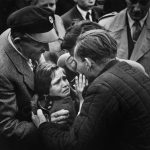When it comes to the greatest Olympians in history, names like Usain Bolt and Michael Phelps often come to mind, but perhaps no one made a more lasting impact than Jesse Owens.
His triumph at the 1936 Berlin Olympics transcended athletics, standing as a powerful symbol against both the racial prejudices of Nazi Germany and the segregated America he returned to.
Owens’ accomplishments weren’t just about gold medals; they became a global statement about human dignity, equality, and the true Olympic spirit.
Keep scrolling down to explore the remarkable life and legacy of Jesse Owens.
Jesse Owens: A rising star in the world of athletics

Jesse Owens was born James Cleveland Owens on September 12, 1913, in Oakville, Alabama. The son of a sharecropper and the grandson of slaves, Owens’ early life was steeped in poverty.
At the age of nine, his family relocated to Cleveland, Ohio, in search of better opportunities, part of the Great Migration of African Americans from the rural South to northern cities.

It was here that a teacher mistakenly called him “Jesse” instead of “J.C.” — a name that stuck with him for the rest of his life.

Owens discovered his talent for running in junior high, quickly earning attention for his speed. He broke records at the high school level and gained a scholarship at Ohio State University.
Despite segregation and being denied housing with white athletes, Owens continued to excel.

In 1935, during the Big Ten Championships in Ann Arbor, Michigan, Owens set three world records and tied a fourth — all in the span of 45 minutes.
This extraordinary feat remains one of the greatest achievements in track and field history.
A chilly reception in Nazi Germany

The 1936 Summer Olympics in Berlin, Germany, were intended to showcase Nazi Germany’s vision of Aryan supremacy to the world.
Adolf Hitler believed the Games would affirm the dominance of white athletes, particularly those of German descent.

Owens faced tremendous pressure leading up to the Games. Civil rights groups urged him to boycott, while in Germany, he was met with racial slurs and hostility.

Nazi ideology viewed African Americans as inferior, and Hitler had hoped their poor performance would support this belief.

Owens’ participation in the Berlin Olympics set the stage for a confrontation between the ideology of the Nazi regime and the athletic excellence of an African American man.
Olympic glory: Four gold medals

Owens began his Olympic quest by winning the 100-meter dash, completing the race in 10.30 seconds, and instantly shattering the myth of Aryan athletic superiority.

Days later, he won the 200-meter dash with a time of 20.70 seconds.
His next victory, in the long jump, became legendary not only for the distance — an impressive leap of 8.06 meters — but also for the camaraderie between Owens and his German competitor, Luz Long, who advised Owens on his technique.

The long jump victory, with Hitler watching from the stands, is one of the most iconic moments of Owens’ career.

Owens later recalled Long’s sportsmanship, even as they competed under the oppressive Nazi regime. Their friendship would become a symbol of how sports can transcend politics and hatred.

Owens’ final gold came in the 4×100-meter relay, where his team set a new world record of 39.80 seconds. In total, Owens won four gold medals, more than any other track and field athlete at a single Olympic Games.
A hero abroad, but struggles at home

Despite his triumphs in Berlin, Owens’ return to the United States was a sobering reminder of the racial segregation still deeply entrenched in his homeland.

Owens himself noted, “Although I wasn’t invited to shake hands with Hitler, I wasn’t invited to the White House to shake hands with the President either.”

In Nazi Germany, Owens was allowed to stay in the same hotel as other athletes, but back in the U.S., he struggled to find employment.

Though a national hero in name, Owens wasn’t immune to the same discrimination and lack of opportunity faced by other African Americans in the 1930s.

He took on numerous odd jobs, even racing against horses to earn money.

It wasn’t until 1976, decades after his Olympic victories, that Owens was awarded the Presidential Medal of Freedom by President Gerald Ford, America’s highest civilian honor.
The legacy of Jesse Owens

Jesse Owens’ legacy continues to inspire generations of athletes and civil rights advocates. His performance in the 1936 Olympics wasn’t just about winning medals; it was about breaking barriers and disproving the dangerous ideologies of racial superiority.

His friendship with Luz Long, who died fighting for Nazi Germany, is a reminder that sportsmanship can transcend politics and race.
Owens’ four gold medals stood unmatched until Carl Lewis equaled the feat in 1984.

Yet, what makes Owens’ achievements truly historic is their context—his victories came at a time when the world was on the brink of war and divisions were drawn along racial lines.
Owens once said, “Find the good. It’s all around you. Find it, showcase it, and you’ll start believing in it.”
His life and achievements are a shining example of this principle, and his legacy continues to inspire people to stand against injustice and believe in the potential of every individual, regardless of race or background.


